This is just a sample of the many
antique Surveyor's Compasses we have sold.
Click link to see other
Past Sales Archive Pages on this Site.
We Buy Quality Surveying Related Antiques
Contact Us at
AntiqBuyer@gmail.com
Special Note Concerning Prices Seen Below:
Most prices seen reflect actual sale results from this website.
Surveying instruments, and especially 19th century compasses, have
experienced a market correction.
Price ranges reflect what I believe to be current values
up to higher bubble era results.
On other pieces you will see no price, or a price range,
with or without an explanation. The reasons for that are discussed on the FAQ page.
Our current offering of Antiques for sale are at our sister Website Patented-Antiques.com.
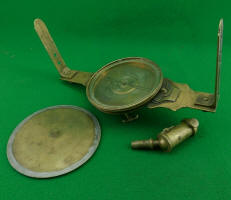 Benjamin
Rittenhouse Surveying Compass w/ Box
Benjamin Rittenhouse was the brother of David Rittenhouse, documented
instrument maker to such famous Americans as George Washington, Benjamin Franklin, and
other notable colonial figures. He worked for the Colonials during the
Revolution making gun locks.
Benjamin
Rittenhouse Surveying Compass w/ Box
Benjamin Rittenhouse was the brother of David Rittenhouse, documented
instrument maker to such famous Americans as George Washington, Benjamin Franklin, and
other notable colonial figures. He worked for the Colonials during the
Revolution making gun locks.
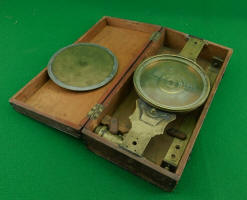
There are numerous bios and articles to be found online about the Rittenhouse family and the instruments they made. There is a detailed history at the SurveyHistory.org site. The Smithsonian site also has info, and several examples in their collection. Their write-up states Benjamin Rittenhouse was the most prolific compass maker of the 18th century and that approx. 3 dozen of his instruments are known. In his later years he went into partnership with several other people and so his pieces can be dated by how they are signed. Examples bearing just his name being the earliest and dating from the 18th century. The decoration and engraving on this example are scant compared to some of his other works. I am not sure if that indicates it is an earlier piece or not.
The compass measures approx. 15 inches long and has a 5 inch blued needle. It is in what appears to be the original box and includes the knuckle joint. There is a compass cover piece as well. There is one good level vial, and a vernier which is operable. A great looking early 19th century surveying instrument of historical importance.
Good + . . . . . . $8750.00 SOLD!!
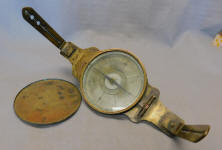 Thomas
Whitney Surveying Compass
The Compass Directory site puts Thomas
Whitney's working dates at
from 1798 to 1823. He was based in Philadelphia PA.
Whitney was a prolific early maker with an interesting history including
the fact that he made instruments for the Lewis & Clark
expedition.William Young apprenticed to him for 7 years before
becoming famous in his own right.The
serial number on this compass is 381.
It is listed in the data base of known instruments he made, and it is dated
as from 1818 in that info. No box. No issues. Good
patina. Nice!!
Thomas
Whitney Surveying Compass
The Compass Directory site puts Thomas
Whitney's working dates at
from 1798 to 1823. He was based in Philadelphia PA.
Whitney was a prolific early maker with an interesting history including
the fact that he made instruments for the Lewis & Clark
expedition.William Young apprenticed to him for 7 years before
becoming famous in his own right.The
serial number on this compass is 381.
It is listed in the data base of known instruments he made, and it is dated
as from 1818 in that info. No box. No issues. Good
patina. Nice!! Good + . . . . . . $795.00 SOLD!!
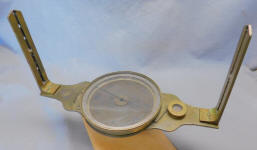 William Young
Surveyor / Surveying Compass William
Young was an early well known Pennsylvania instrument maker. This compass is a
pretty nice example with a nice even unpolished patina. It is a pre
Civil War era piece dating from the 1850s. The serial number
found on the compass face is 3318.There is no box.The one apology is the
circular level vial is
dry. Some of the pics show it w/o the glass or needle as there was
a lot of glare w/ them in place. A nice display piece.
William Young
Surveyor / Surveying Compass William
Young was an early well known Pennsylvania instrument maker. This compass is a
pretty nice example with a nice even unpolished patina. It is a pre
Civil War era piece dating from the 1850s. The serial number
found on the compass face is 3318.There is no box.The one apology is the
circular level vial is
dry. Some of the pics show it w/o the glass or needle as there was
a lot of glare w/ them in place. A nice display piece. Good . . . . . . . $595.00 SOLD!!
 Troughton & Simms / London Compass & Sundial
A very interesting
surveying / navigation device that dates from the 19th century. This
is a genuine antique and not to be confused with new fake versions offered as
antiques.
Troughton & Simms / London Compass & Sundial
A very interesting
surveying / navigation device that dates from the 19th century. This
is a genuine antique and not to be confused with new fake versions offered as
antiques.The Leatherette / Sharkskin covered wooden box is nice as well. This combination sundial and compass is such an iconic design that it has been copied numerous times and those copies and fake versions are now being offered all over the internet as "antiques and "vintage" whatever those words have come to mean today, or better put, how they have lost their true meaning.
The compass face is nicely engraved and is in fine condition. The compass is functioning. All bubbles are good. No issues or problems. Has a nice even patina and will display nicely.
Fine . . . . . . $895.00 SOLD!!
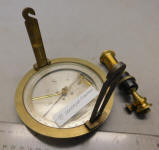 French
Surveying Compass These small compasses date
from around the turn of the century. American instrument makers and
survey supply distributers
as well as large regional retailers imported them as a second line for
casual users / buyers. This has the knuckle joint.No box.
It either fell or was hit by something at some point as one of the level
bubbles is broken and the brass housing for it is dented. The needle swings,
but does not seem accurate. Suitable for display only.
French
Surveying Compass These small compasses date
from around the turn of the century. American instrument makers and
survey supply distributers
as well as large regional retailers imported them as a second line for
casual users / buyers. This has the knuckle joint.No box.
It either fell or was hit by something at some point as one of the level
bubbles is broken and the brass housing for it is dented. The needle swings,
but does not seem accurate. Suitable for display only.
Good. . . . $40.00 SOLD!!
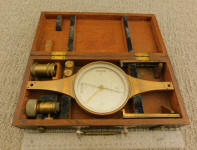 K
& E / Keuffel & Esser Survey Compass
Here is an interesting and unusually small and lightweight surveyors compass at just
about 12 inches long.The box has a brass label with a serial #
28958 that matches the # under the glass. That would date this compass from shortly after the turn of
the century. It is in fine overall condition.
K
& E / Keuffel & Esser Survey Compass
Here is an interesting and unusually small and lightweight surveyors compass at just
about 12 inches long.The box has a brass label with a serial #
28958 that matches the # under the glass. That would date this compass from shortly after the turn of
the century. It is in fine overall condition. The compass face is 4" Dia. The plate or arms are cast brass with an turned edge that gives it depth, and added strength as the arms are so thin. The sight vanes fit well and are 4 1/2" tall. The compass needle measures just under 4" swings to north and the lock operates. The level vials are located under the glass and are full. It comes with a nice knuckle joint staff adapter. The box is nice. A nice looking early 20th century surveying instrument that will display nicely.
Good + . . . . . . . $495.00 SOLD!!
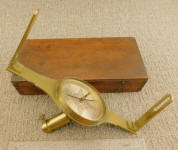 S. Browning & Son Boston Survey Compass
Here is a very nice looking and at just over 12 inches a smaller than usual surveyors compass. The compass is in fine overall condition. The box has a label inside the lid that gives
information about what types of instruments Samuel Browning was making at the time.
The list included what he calls off as a Rittenhouse Nonius compasses.
Nonius being another word for vernier. Samuel Browning's'
working dates in Boston span from approx. 1813 to the early 1840s.
After that he spent time in Baltimore until his death in 1864.
S. Browning & Son Boston Survey Compass
Here is a very nice looking and at just over 12 inches a smaller than usual surveyors compass. The compass is in fine overall condition. The box has a label inside the lid that gives
information about what types of instruments Samuel Browning was making at the time.
The list included what he calls off as a Rittenhouse Nonius compasses.
Nonius being another word for vernier. Samuel Browning's'
working dates in Boston span from approx. 1813 to the early 1840s.
After that he spent time in Baltimore until his death in 1864. The compass face is 4" Dia. and the needle approx. 3 1/2" long. The face is very nicely engraved with a floral motif and a large Fleur De Lie at the North Point. Note that the compass mid points are called off and not North, South, East, and West. An interesting variation. The sight vanes fit well and are approx. 5" tall" tall. The compass needle measures swings to north and the lock operates.There are no levels, and I saw an ad for Brownings instruments saying he offered them as such. It comes with a nice knuckle joint staff adapter. The two thumbscrews to hold the sight vanes are the same size and interchangeable with a slightly different look. The box is nice. A nice looking early 20th century surveying instrument that will display nicely.
Fine . . . . . . . $995.00 SOLD!!
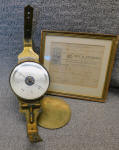 William
Stieren Vernier Surveyor's Compass w/ Original Purchase Receipt
William Stieren was a little known Pittsburgh PA instrument maker & dealer of surveying
instruments and other related scientific articles. (see pic of original
receipt ). He is not listed at the Smithsonian site and there is
just a very short bio on him in Smarts book on surveying instrument makers.
Information on the internet about him is scant, but all
is not lost as this survey compass comes with its original receipt dated
1890 with a wealth of further historical info included. It lists Wm. Stieren
primarily as an optician on the receipt but there is so much more.
William
Stieren Vernier Surveyor's Compass w/ Original Purchase Receipt
William Stieren was a little known Pittsburgh PA instrument maker & dealer of surveying
instruments and other related scientific articles. (see pic of original
receipt ). He is not listed at the Smithsonian site and there is
just a very short bio on him in Smarts book on surveying instrument makers.
Information on the internet about him is scant, but all
is not lost as this survey compass comes with its original receipt dated
1890 with a wealth of further historical info included. It lists Wm. Stieren
primarily as an optician on the receipt but there is so much more.An interesting thing to note is that Stieren died in 1887 when the receipt is dated 1890. The receipt gives us a clue as to how that is possible as it lists two other partners in the firm, also with the name Stieren who continued the business for an unknown amount of time after the founders death. The receipt also gives us the price of the compass at $42.00, and tripod for $8.00. There is the further notation that the buyer was allowed a credit of $23.00 for the instrument he traded in at the time. One can only wonder if that compass was by Rittenhouse, Chandlee or some other 18th century instrument maker.
The compass measures approx. 15 inches long and the compass has a 5 1/2 inch needle.There is just the points, maker and location name engraved on the silvered face. The compass needle swings freely and points north. It has a nicely engraved Fleur d' Lei at the North point The compass face shows no wear or tear and is like new. The body shows little or no wear as well and there is a lot of the original lacquer finish remaining. The crack seen in the glass has been repaired. While both level bubbles are good and look original, one is blue / green, and one clear. There is no box, but does come with the display stand shown. All in all a nice looking and relatively rare surveying instrument by an obscure maker from western PA.
Fine . . . . . . $695.00 SOLD!!
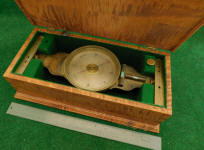 Jacob Blattner Survey Compass Jacob Blattner
worked out of St Louis MO during the mid to late 19th century. He
immigrated here from Switzerland. The compass measures approx. 15 inches
long. The compass needle swings to north and the lock operates.
The 2 level vials are full. The vernier adjuster works and is
controlled by a thumbscrew on the bottom.The sight vanes fit the instrument
well, and are a perfect fit in the box front to back as well. The tiger maple box is an
aftermarket creation. It was nicely done and well thought out. A nice looking
early 19th century surveying instrument that will look nice on display.
Jacob Blattner Survey Compass Jacob Blattner
worked out of St Louis MO during the mid to late 19th century. He
immigrated here from Switzerland. The compass measures approx. 15 inches
long. The compass needle swings to north and the lock operates.
The 2 level vials are full. The vernier adjuster works and is
controlled by a thumbscrew on the bottom.The sight vanes fit the instrument
well, and are a perfect fit in the box front to back as well. The tiger maple box is an
aftermarket creation. It was nicely done and well thought out. A nice looking
early 19th century surveying instrument that will look nice on display. Good + . . . . . . $595.00 SOLD!!
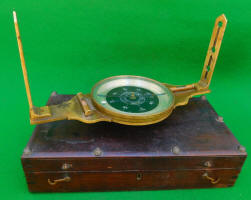 James
Green Baltimore Maryland Black Face Survey Compass w/ Tripod
James Green compasses are not seen very often. He was born circa 1808
and was first listed in Baltimore directories in the mid 1830's as a
philosophical instrument maker. Smart theorizes Green moved to New
York in 1850 and continued in business there for a number of years.
James
Green Baltimore Maryland Black Face Survey Compass w/ Tripod
James Green compasses are not seen very often. He was born circa 1808
and was first listed in Baltimore directories in the mid 1830's as a
philosophical instrument maker. Smart theorizes Green moved to New
York in 1850 and continued in business there for a number of years. The compass measures approx. 15 inches long and has a 5 1/2 inch needle. The needle swings to north and the lock operates. The center of the silvered compass face is finished in black and it has a nicely engraved Fleur d' Lei at the North point. The level vials are full. The tally keeper which is built into the compass face under the glass works. The box is nice and has a series of lead buttons across the top. I assume so one could stack other boxes on top without damaging the box. The tripod is original and has a great period repair to one leg. All in all a nice looking early 19th century surveying instrument that will look nice on display.
Fine . . . . . . $1100.00 SOLD!!
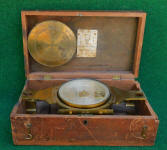 Reed
Gimbal Mining Compass
A very unusual configuration where the main compass is gimbaled in the frame
so that it can freely swivel to find level in hilly conditions or in mines.
It is numbered 318.
Reed was a mid 19th century maker based in Pittsburg PA is is known for
other mining related pieces. Note also the design of the sight vanes
and how they attach without ever removing the thumbscrew. A neat
idea. Nice!!
Reed
Gimbal Mining Compass
A very unusual configuration where the main compass is gimbaled in the frame
so that it can freely swivel to find level in hilly conditions or in mines.
It is numbered 318.
Reed was a mid 19th century maker based in Pittsburg PA is is known for
other mining related pieces. Note also the design of the sight vanes
and how they attach without ever removing the thumbscrew. A neat
idea. Nice!!
Good + . . . . . . $1750.00 SOLD!!
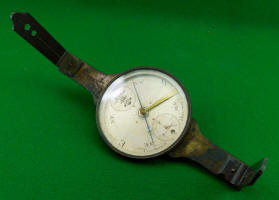 Benjamin Chandlee &
Robert Holloway / Baltimore Surveying Compass
Surveying instruments bearing the name Chandlee are considered one of the
most desirable, rare, and interesting of all Colonial era American
surveying instruments. The tradition was begun by Goldsmith
Chandlee, maker of instruments for the likes of George Washington, Thomas
Jefferson, Benjamin Franklin and other notable American figures. Benjamin Chandlee III was Goldsmith Chandlee's
son, and continued the tradition of making surveying instruments started by his father.
Benjamin Chandlee &
Robert Holloway / Baltimore Surveying Compass
Surveying instruments bearing the name Chandlee are considered one of the
most desirable, rare, and interesting of all Colonial era American
surveying instruments. The tradition was begun by Goldsmith
Chandlee, maker of instruments for the likes of George Washington, Thomas
Jefferson, Benjamin Franklin and other notable American figures. Benjamin Chandlee III was Goldsmith Chandlee's
son, and continued the tradition of making surveying instruments started by his father. There are numerous Bios and other references to the Chandlee family and the instruments they made available online. There is a detailed history on Goldsmith Chandlee by Elgin to be found at the SurveyHistory.org site, and a shorter one by Smart on Benjamin Chandlee at the same site. Benjamin Chandlee was born in 1780 and died in 1822. His working dates in Baltimore are from 1814 up to the time of his death. He was in partnership with Holloway from 1819 until his death in 1822, thus dating this compass from that period. Online research indicates that this is but one of 1/2 dozen or so compasses made by this partnership known to exist
The compass measures approx. 15 inches long and has a 5 inch blued needle.It is in original untouched condition with a great patina. There is a hairline crack in one sight vane. It is stable and there is no movement. The needle swings to north and the lock operates. There is a functioning double tally keeper built into the compass face under the glass. The silvered compass face is nicely engraved with a great looking Fleur de Lis at the north point. The name Chandlee & Holloway with the Baltimore location are at the bottom of the compass face. A great looking early 19th century surveying instrument of historical importance.
Fine . . . . . . $5950.00 SOLD!!
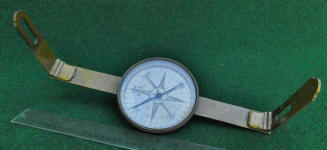 Anthony Lamb New York Surveyor Compass Beautifully
engraved.
Anthony Lamb is considered New Yorks earliest instrument maker and examples
of his work are rare. He set up shop in New York in the 1730's after coming
to the US from England.
Anthony Lamb New York Surveyor Compass Beautifully
engraved.
Anthony Lamb is considered New Yorks earliest instrument maker and examples
of his work are rare. He set up shop in New York in the 1730's after coming
to the US from England.There is a nice Bio on him at the Smithsonian and another at the Compass Makers site. There is even a more in depth one on a site describing great collectibles that have come to market over the years. That article can be found at this link http://www.greatestcollectibles.com/compass-online-price/#.WyPFqkgvxPY
Note how the sight vanes are a dovetail fit. Both have early and nicely done repairs that adds character and attest to it authenticity. Lambs name is engraved on the right arm. Note also the Rams horn thumbscrews on the underside. Very early, rare and Nice!!
Good + . . . . . . $6950.00 SOLD!!
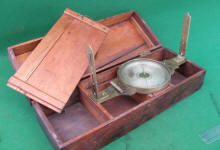 James
Reed Surveyor's Compass James Reed hailed
from Pittsburg PA and his working dates were from the mid 1800's till his
death in 1878. The silvered compass face is engraved with the company
name and location as well as the serial #328. The box is period, and
fitted for the compass, but larger than one would expect to see with
additional built in compartments including a spring fitted lid in the top
portion.
James
Reed Surveyor's Compass James Reed hailed
from Pittsburg PA and his working dates were from the mid 1800's till his
death in 1878. The silvered compass face is engraved with the company
name and location as well as the serial #328. The box is period, and
fitted for the compass, but larger than one would expect to see with
additional built in compartments including a spring fitted lid in the top
portion. Good + . . . . . . $895.00 SOLD!!
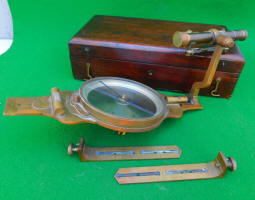 William Young & Sons
Surveying Compass w/ Auxiliary Scope This Young & Sons
Surveying Compass w/ Auxiliary Scope is a wonderfully graphic piece of Early
American Surveying Instrument Technology and Americana
which dates from approx. 1876 and the era of the American
Centennial. The serial # is 4792. It is in overall fine
condition.
William Young & Sons
Surveying Compass w/ Auxiliary Scope This Young & Sons
Surveying Compass w/ Auxiliary Scope is a wonderfully graphic piece of Early
American Surveying Instrument Technology and Americana
which dates from approx. 1876 and the era of the American
Centennial. The serial # is 4792. It is in overall fine
condition.William Young was one of Americas first well known instrument makers in America. He worked out of Philadelphia and was the first American instrument maker to own a dividing engine, which he designed and built himself. Young is also credited by some to have designed and produced the first American Transit, although that claim is open to discussion. The design of this instrument, a surveyors compass with attached auxiliary scope speaks to the progression of that idea and design.
By the time this instrument was made, Alfred, one of his sons had taken over the company. It was right around this time that they first began marking their instruments Young and Sons. This early and famous firm was located in Philadelphia, producing a quality line of instruments right up until they were acquired by Keuffel and Esser around 1918. Even then K & E continued to offer a separate line of instruments with the Young name so as to maintain that customer base which had been built up over the years.
This compass is approx. 16" long, and the compass face measures 6" with a 5 1/2 inch needle. It operates, points north and the needle lock is operable. The level vials are all full and appear to be original. The tally keeper is functional. The optics of the 7 1/2" rare auxiliary scope are clear and bright. The sight vanes are both present and nice. The box has classic dovetail joints from the period and in general is very nice. In addition to the Young paper label inside the top of the box, there is also some writing in pencil that is hard to make out.
Fine . . . . . . $1995.00 SOLD!!
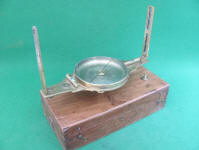 James
Queen Survey Compass James Queen of
Philadelphia PA was first listed as an optician in
the 1839 Philadelphia Directories. He expanded the business took in a
partner and renamed it
James Queen & Co. This company became a distributer for many scientific and surveying
related products. He had a long relationship with Gurley. The
label inside the lid of the box would date this piece from the early 1890's
or before as the company name changed to Queen & Co. in 1893.
James
Queen Survey Compass James Queen of
Philadelphia PA was first listed as an optician in
the 1839 Philadelphia Directories. He expanded the business took in a
partner and renamed it
James Queen & Co. This company became a distributer for many scientific and surveying
related products. He had a long relationship with Gurley. The
label inside the lid of the box would date this piece from the early 1890's
or before as the company name changed to Queen & Co. in 1893. The compass measures approx. 15 inches long and has a 5 1/2 inch needle. The needle points north. The silvered face of the compass is in nice condition and it has a nicely engraved Fleur d' Lei at the North point. It has an issue with one sight vane in that the threaded hole to receive the thumb screw is stripped. The other sight vane had the same issue and has an early and ingenious repair that can be mimicked to make this other one OK. A threaded brass sleeve was made and inserted into a new larger drilled hole. It looks fine, and is almost invisible. The level vials are full. The tally keeper works. The box is nice. All in all a nice looking early 19th century surveying instrument that will look nice on display.
Good . . . . . . $500.00 SOLD!!
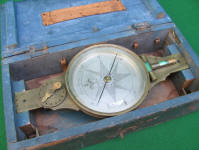 Andrew
Meneely Vernier Surveying
Compass in Period Box Andrew Meneely is a well
documented instrument maker from West Troy in upstate NY near Albany.
There are numerous bios on him to be found online. He was also well known for the manufacture of
church and school type bells. Andrew Meneely was born in 1802 and died in
1851. He apprenticed to Julius Hanks one of the premier surveying and
scientific instrument makers of the
time. He struck out on his own sometime in the 1820's. In 1849 the
name engraved on his instruments changed when his son joined the company thus
dating this instrument from between those two dates.
Andrew
Meneely Vernier Surveying
Compass in Period Box Andrew Meneely is a well
documented instrument maker from West Troy in upstate NY near Albany.
There are numerous bios on him to be found online. He was also well known for the manufacture of
church and school type bells. Andrew Meneely was born in 1802 and died in
1851. He apprenticed to Julius Hanks one of the premier surveying and
scientific instrument makers of the
time. He struck out on his own sometime in the 1820's. In 1849 the
name engraved on his instruments changed when his son joined the company thus
dating this instrument from between those two dates. The condition is very nice. The overall length is approx. 15". The silvered compass face and engraving are very nice. The serial number inscribed on the face is 247 indicating an instrument made during the early years of his working dates. This Meneely compass has a lot more engraving than the example above. The 8 point compass rose is very finely and precisely done. It has a great looking North point Fleur de Lis. Not over done, and yet pleasing with lots to look at. The needle swings freely and points north. It has an out keeper dial numbered 0 - 16. The level vials are both good. The compass has a pleasing overall patina. Same for the sight vanes. The deviation vernier is controlled from below the plate. The box is probably not original, but is period and has a nice look to it.
A very nice looking and historically significant instrument that will look great on display!!
Good + . . . . . $1200.00 SOLD!!
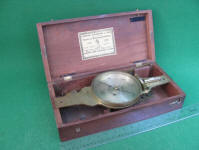 Samuel
Thaxter & Sons Survey Compass
Samuel Thaxter was first listed as an scientific instrument maker / importer
of instruments in
the 1796 Boston Directories. The Directory entries changed to include his
son about 1822. He died in 1842, and so I assume this brass compass
dates from between those dates.
Samuel
Thaxter & Sons Survey Compass
Samuel Thaxter was first listed as an scientific instrument maker / importer
of instruments in
the 1796 Boston Directories. The Directory entries changed to include his
son about 1822. He died in 1842, and so I assume this brass compass
dates from between those dates.The compass measures approx. 15 inches long and has a 5 inch needle. The needle points north. The silvered face of the compass is in very nice condition, and it has a nicely engraved Fleur d' Lei at the North point. There is additional engraving around the compass rose / center point. It comes complete with the often missing knuckle joint to fit it to a staff. The sight vanes fit well, and the level vials are full. The box is nice and it has a good label inside. All in all a nice looking early 19th century surveying instrument that will look great on display.
Fine . . . . . . $900.00 SOLD!!
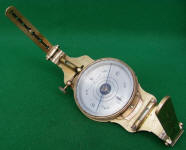 Adolph Tiensch of Memphis Tenn. Surveying Compass
This
Civil War era surveying compass is by a little known obscure maker, Aldoph Tiensch who was born in Germany
in 1820 and came to America
in the early 1800's. He first set up shop in Ohio in the late 1840's -
early 1850's. He moved to and is listed in Kentucky directories as an
instrument maker up till about 1860. He was first listed as a maker of scientific instruments in
Tennessee in 1867 but is believed to have been there since 1860. He
died in Memphis in 1895. Few of his instruments are found and scientific
instrument makers from
this region of the country are scarce.
Adolph Tiensch of Memphis Tenn. Surveying Compass
This
Civil War era surveying compass is by a little known obscure maker, Aldoph Tiensch who was born in Germany
in 1820 and came to America
in the early 1800's. He first set up shop in Ohio in the late 1840's -
early 1850's. He moved to and is listed in Kentucky directories as an
instrument maker up till about 1860. He was first listed as a maker of scientific instruments in
Tennessee in 1867 but is believed to have been there since 1860. He
died in Memphis in 1895. Few of his instruments are found and scientific
instrument makers from
this region of the country are scarce. The instrument is approx. 15" long overall. It is in nice overall condition. All the motions work easily, and both level vials are full and appear to be original. It has the interesting feature of having folding sight veins that are also removable as in typical instruments. The vernier scale is controlled by a top mounted adjuster. The instrument was cleaned sometime in the past, but has developed a nice even patina over the years. There is no box. Nice!!
Fine . . . . . $900.00 SOLD!!
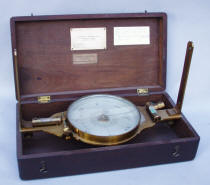 Roach & Warner Surveyors Compass
This surveyor's compass dates from the early to mid
1800's and is in very nice original condition. Roach is a well known but
relatively rare maker who started out his instrument making career on the East
Coast in New York after he came here from Ireland. He started out in the
mid 1830's or so in a partnership with Warner, and that is how this instrument
is marked. By 1850 or so he was listed in the directories of San Francisco
as a maker of scientific instruments and surveying equipment. He was soon
the best known and largest maker on the west coast.
Roach & Warner Surveyors Compass
This surveyor's compass dates from the early to mid
1800's and is in very nice original condition. Roach is a well known but
relatively rare maker who started out his instrument making career on the East
Coast in New York after he came here from Ireland. He started out in the
mid 1830's or so in a partnership with Warner, and that is how this instrument
is marked. By 1850 or so he was listed in the directories of San Francisco
as a maker of scientific instruments and surveying equipment. He was soon
the best known and largest maker on the west coast.
This compass is in very nice condition exhibiting large amounts of its original finish. It appears that one vial has been refilled as the two have different color vials. . The labels inside the top indicate that this instrument was at one time in the Boston area being worked on or adjusted by the Leder and Probst there. Another tag says it was purchased from them in 1919, and then that fellow gave it to the next owner in 1959. The original Roach & Warner label is still here as well giving the location of 292 Broadway New York. The compass measures just under 16" overall, and the compass face is approx 6 3/4" with the needle being 6". The compass face is very nicely engraved with a floral and vine motif. The ball and socket mount for the Jacob staff is also present. A rare and desirable instrument in condition not typically found.
Good . . . . . $1000.00 - $2000.00 SOLD
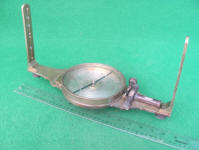 D.
T. Lillie & Co. New Orleans Surveying
Compass D. T. Lillie, the maker of this
compass is an undocumented instrument maker on the usual surveying history
sites, and he is not listed in Smarts book on instrument makers. There is little mention of him using Google searches
either. I did
find a directory listing for him in a copy of the 1843 New Orleans
directory. The compass has the look of an early to mid 19th century New York
maker with the style engraving around the compass rose. Perhaps he
moved to warmer climates to have less competition. The
needle swings freely and points north. The silvered compass face is
very nice. The level vials are both good and have a nice patina.
The compass body has been cleaned at some point and has a different patina
from the bottom and level vials. There is no box. A rare
compass from a region not at all well known for manufacturing thing of this
sort.
D.
T. Lillie & Co. New Orleans Surveying
Compass D. T. Lillie, the maker of this
compass is an undocumented instrument maker on the usual surveying history
sites, and he is not listed in Smarts book on instrument makers. There is little mention of him using Google searches
either. I did
find a directory listing for him in a copy of the 1843 New Orleans
directory. The compass has the look of an early to mid 19th century New York
maker with the style engraving around the compass rose. Perhaps he
moved to warmer climates to have less competition. The
needle swings freely and points north. The silvered compass face is
very nice. The level vials are both good and have a nice patina.
The compass body has been cleaned at some point and has a different patina
from the bottom and level vials. There is no box. A rare
compass from a region not at all well known for manufacturing thing of this
sort.
Good +. . . . .$600.00 - $900.00 SOLD!!
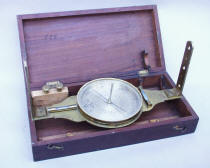 Frye
& Shaw Surveyors Compass This surveyor's compass
dates from the mid 1800's and is in super original condition.
The partnership of Frye & Shaw (1837-1845) was
formed by Addington D. Frye and Robert Ludlow Shaw and was located in New York
City. The dovetailed
box is original and very nice. It will make a great display piece. Very
nice!
Frye
& Shaw Surveyors Compass This surveyor's compass
dates from the mid 1800's and is in super original condition.
The partnership of Frye & Shaw (1837-1845) was
formed by Addington D. Frye and Robert Ludlow Shaw and was located in New York
City. The dovetailed
box is original and very nice. It will make a great display piece. Very
nice!
Good . . . . .$800.00 - $1500.00 SOLD
There is a nice bio at the Smithsonian site found Here:
http://americanhistory2.si.edu/collections/surveying/object.cfm?recordnumber=745994
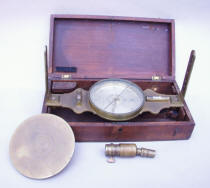 Gregg
& Rupp Surveyors Compass This surveyor's compass
dates from the mid 1800's and is in super original condition. This
was a New York based outfit and it is done in that style. The dovetailed
box is original and very nice as well. It will make a great display piece.
Very nice!
Gregg
& Rupp Surveyors Compass This surveyor's compass
dates from the mid 1800's and is in super original condition. This
was a New York based outfit and it is done in that style. The dovetailed
box is original and very nice as well. It will make a great display piece.
Very nice!
Good + . . . . .$800.00 - $1500.00 SOLD
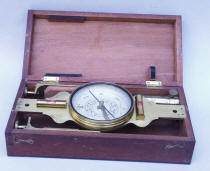 Levi
Colton Surveyors Compass This surveyor's compass
dates from the mid 1800's and is in super original condition. Colton began
his career in Washington, and then moved to New York and finally Connecticut.
This one is nicely engraved in the New York style of the period. It is
complete and in very nice original condition. The dovetailed box is original
and very nice as well. It is smaller than typically seen and will make a great
display piece. Very nice!
Levi
Colton Surveyors Compass This surveyor's compass
dates from the mid 1800's and is in super original condition. Colton began
his career in Washington, and then moved to New York and finally Connecticut.
This one is nicely engraved in the New York style of the period. It is
complete and in very nice original condition. The dovetailed box is original
and very nice as well. It is smaller than typically seen and will make a great
display piece. Very nice!
Good +. . . . .$800.00 - $1500.00 SOLD
Below is biographical information from the Smithsonian site.
Colton Levi Colton (1803-1885) was born in Massachusetts, and trained as a jeweler and silversmith. He may have learned the art of instrument making from Richard Patten, for whom he worked in Washington, D.C. in 1846, and who described him as ďa quite steady and industrious man.Ē Around 1850 Colton was making compasses in New York City, and in the mid-1850s he was making compasses in Hartford, Connecticut.
William Young & Sons Compass w/ Auxiliary Scope Serial # 4798 This is a wonderfully graphic piece of Early Americana and American Technology which dates from approx 1876 and the era of the American Centennial. William Young was the first American instrument maker to own a dividing engine which he designed and built himself. He is also credited with designing the first American Transit. By the time this instrument was made one of his sons, Alfred had taken over the company, and it was right around this time that they fist began marking their instruments Young and Sons. This early and famous firm was located in Philadelphia, producing a quality line of instruments right up until they were acquired by Keuffel and Esser around 1918. Even then K & E continued to offer a separate line of instruments with the young name so as to maintain that customer base which had been built up over the years. This compass is approx 16" long, and the compass measures 6" with a 5 1/2 inch needle which operates just fine. The level vials are all full and appear to be original. The optics of the 7 1/2" rare auxiliary scope are clear and bright. There is one decorative small brass cover missing over the vernier adjust on the right hand side up against the compass. This can be seen in one of the pics. It is minor and does not affect operation. The sight vanes are both present and nice. The box has classic dovetail joints from the period and in general is very nice.
Good . . . . .$1000.00 - $2500.00 SOLD
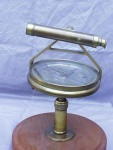 Randolph's
1879 Patent Surveyors Telescopic Level Theodore Randolph was a well known instrument maker in
Ohio during his working period from roughly 1850 to near the turn of the century.
He won several awards at exhibitions and first drew a patent for this style
of telescopic compass in 1879. Randolph was born, raised, and operated
his business in Cincinnati Ohio from the mid 1800's to just before the turn
of the century. This instrument has a detachable telescope that can be
removed. The optics are good / clear, and the compass is operational.
The level vials are full and appear to be original. The silvered Vernier
is nice, and the keeper works as well. This piece was cleaned a long time
ago and has a nice mellow look to it after years of aging. A nice
piece from a hard to find maker that will make a very nice display.
Randolph's
1879 Patent Surveyors Telescopic Level Theodore Randolph was a well known instrument maker in
Ohio during his working period from roughly 1850 to near the turn of the century.
He won several awards at exhibitions and first drew a patent for this style
of telescopic compass in 1879. Randolph was born, raised, and operated
his business in Cincinnati Ohio from the mid 1800's to just before the turn
of the century. This instrument has a detachable telescope that can be
removed. The optics are good / clear, and the compass is operational.
The level vials are full and appear to be original. The silvered Vernier
is nice, and the keeper works as well. This piece was cleaned a long time
ago and has a nice mellow look to it after years of aging. A nice
piece from a hard to find maker that will make a very nice display.
Good . . . . .$500.00 - $800.00 SOLD
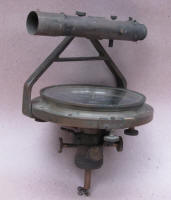 Randolph's
1879 Patent Surveyors Telescopic Level w/
Compass This instrument has a detachable telescope that can be removed.
The optics are good / clear. There are a couple of empty screw holes in the scope body that i do not know what
went there. This can be seen in the pics. The compass is operational and the 2 level vials embedded in the
compass face are full with green blue liquid and appear to be original. The outer silvered Vernier is nice.
The compass face measures approx 5" and it has a 4" needle which is operational. The bronzed compass face
is very nice, and the serial # is 4440. This piece has never been cleaned and has a nice patina.
The bottom connector is present and is prepared to be fitted to a tripod or staff with the threaded adapter
which has a spring loaded quick release feature.
Randolph's
1879 Patent Surveyors Telescopic Level w/
Compass This instrument has a detachable telescope that can be removed.
The optics are good / clear. There are a couple of empty screw holes in the scope body that i do not know what
went there. This can be seen in the pics. The compass is operational and the 2 level vials embedded in the
compass face are full with green blue liquid and appear to be original. The outer silvered Vernier is nice.
The compass face measures approx 5" and it has a 4" needle which is operational. The bronzed compass face
is very nice, and the serial # is 4440. This piece has never been cleaned and has a nice patina.
The bottom connector is present and is prepared to be fitted to a tripod or staff with the threaded adapter
which has a spring loaded quick release feature.
Good . . . . .$500.00 - $800.00 SOLD
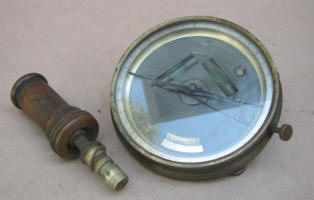 Patented T. F. Randolph Vernier Compass
w/ 4' Needle This surveying
compass is marked with the maker name T. F. Randolph, and the location
Cincinnati. Ohio as well as the patent date of June 12th 1871.
Theodore Randolph's working dates were from roughly 1850 to near the turn of
the century. He was a well known and respected surveying instrument maker
from Cincinnati Ohio. He won several awards at exhibitions and first drew a
patent for this style of compass in 1871.
Patented T. F. Randolph Vernier Compass
w/ 4' Needle This surveying
compass is marked with the maker name T. F. Randolph, and the location
Cincinnati. Ohio as well as the patent date of June 12th 1871.
Theodore Randolph's working dates were from roughly 1850 to near the turn of
the century. He was a well known and respected surveying instrument maker
from Cincinnati Ohio. He won several awards at exhibitions and first drew a
patent for this style of compass in 1871. This instrument has two thumbscrews on the bottom to attach an auxiliary telescope that can be removed and is missing. The compass is operational and the 2 level vials embedded in the compass face are full with green blue liquid and appear to be original. The outer silvered Vernier is nice. There is a keeper / numbered dial that is operational as well. The compass face measures approx 5" and it has a 4" needle which is operational. The locking feature for the needle works, but is close to being stripped and is fragile. The bronzed compass face is very nice, and the serial # is 1121. This compass has never been cleaned and has a nice patina. The bottom knuckle joint connector has a spring loaded quick release feature and is prepared to be fitted to a staff .
A nice piece from a hard to find maker that will make a very nice display.
Good . . . . .$300.00 - $500.00 SOLD!
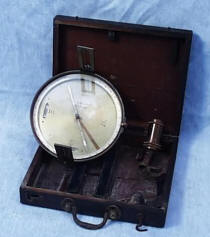 K
& E Forrester Compass These small
compasses were made for work on the go out in the field. Every
major maker offered a version, and here is the Keuffel & Esser model in
nice condition.
K
& E Forrester Compass These small
compasses were made for work on the go out in the field. Every
major maker offered a version, and here is the Keuffel & Esser model in
nice condition.
Good . . . . .$100.00 - $200.00 SOLD
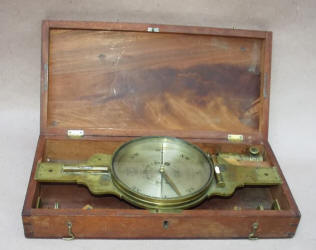 Robert
Shaw Surveyor's Compass Robert Shaw was
born in New York City in 1817 and worked there throughout his career.
He died in 1876. From what I have read he learned his trade and worked
with from John H. Wheeler another early New York instrument maker prior
to opening his own shop. In Smarts' bio on him he says that Shaw was
listed individually in 1836 as a instrument maker at the 222 Water St.
location. After that and until 1845 he was listed as having Addington
Frye as a partner.
Robert
Shaw Surveyor's Compass Robert Shaw was
born in New York City in 1817 and worked there throughout his career.
He died in 1876. From what I have read he learned his trade and worked
with from John H. Wheeler another early New York instrument maker prior
to opening his own shop. In Smarts' bio on him he says that Shaw was
listed individually in 1836 as a instrument maker at the 222 Water St.
location. After that and until 1845 he was listed as having Addington
Frye as a partner.
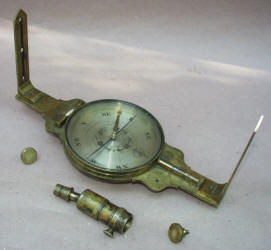 I suppose this surveyors compass
with the location given could date from just after he first opened shop
in 1836-1837, and before 1838 when he was in partnership with Addington
Frye, or after 1845 when the partnership dissolved. Later Directories
indicate that Shaw was in business by himself at several other locations
in the city after 1845 and in his later working years
I suppose this surveyors compass
with the location given could date from just after he first opened shop
in 1836-1837, and before 1838 when he was in partnership with Addington
Frye, or after 1845 when the partnership dissolved. Later Directories
indicate that Shaw was in business by himself at several other locations
in the city after 1845 and in his later working yearsSeveral years ago I had and sold a compasses marked with both names that was very similar in design and decoration to this compass. There is a picture of that compass in the archives if you care to look.
The overall condition of this surveying compass is superb. The vanes fit nicely, and the knuckle joint is present. It is all original and its patina has developed to a warm glow only possible after 150 years of careful storage. The compass face has very detailed and nicely done engraving around the ring and at the points. Early New York instrument makers were proud of their work, and it shows in the level of quality and detail that was put into this piece. The box is proper and a very nicely figured burled / flamed Walnut. It has a iridescence or shimmering quality even today nearly 150 years after it was made from the wood. Several years ago I had a Shaw & Frye Compass, but otherwise they are very hard to find today, and are considered rare in most instances. A very nice piece that is highly recommended!
Fine . . . . . . .$800.00 - $1500.00 SOLD!
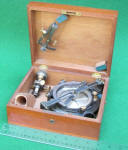 W.
& L. E. Gurley # 276 Pocket Solar Compass Gurley pocket solar compasses are a rare
and unusual surveying instrument. The condition of this
example is second to none. It is near mint!!
W.
& L. E. Gurley # 276 Pocket Solar Compass Gurley pocket solar compasses are a rare
and unusual surveying instrument. The condition of this
example is second to none. It is near mint!!The basic idea behind solar attachments and their use in surveying was first developed by William Burt in the 1830's. Gurley bought the rights to use his idea and incorporated it into both their transits and their line of compasses. Gurley first introduced this near miniature solar size compass in 1880. It was discontinued in about 1918 when it no longer appeared in their catalogs.In their catalog description Gurley claimed that this style compass was nearly as accurate as their larger models, far lighter and easier to carry into the field. It weighs in at under 5 lbs, while the standard size compass was closer to 15 lbs.
Solar compasses were developed to be used in place of regular compasses that were subject to error due to large deposits of iron that would adversely affect a regular compass. The idea was to use the sun and horizon to accurately find ones position. Much as sea faring adventures had done, and did with instruments like sextants and octants.
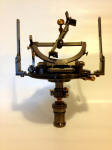
The overall condition is near mint with original patina. The lacquer finish is near perfect with just minor losses, i.e.. scratches on the bottom. It has never been cleaned, and when you move the hour arc you can see the original polished silver scales under the clamps. This points to just how little this instrument was ever used. All motions operate freely, and the plate and both verniers move freely. The 3" needle swings freely. The compass face is inscribed with the Gurley name and Troy NY location. There is no serial # which would indicate this dates from before 1908. There is an example of one of these pictured in the Skerritt book that illustrates Charles Smart's collection of surveying instruments. In it he states that Smart's Pocket Solar Compass was Smarts favorite instrument in the collection.
This style instrument was designed to be used on either a staff or tripod. There is no leveling head other than the swivel ball joint stored in the box. I do have a small light weight tripod that will fit the mount that can be purchased separately. I also have NOS staffs that will work well with this instrument listed on another page.
An important surveying related instrument ready for inclusion in the finest collection of surveying instruments, Scientific instruments, or significant Americana. Highly recommended.
Fine . . . . . .$2,500.00 - $4,500.00 SOLD!!
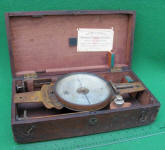 Edmund
Draper Surveyor's Compass Edmund Draper was an
early and important Philadelphia instrument maker, Edmund Draper (1805-1882)
apprenticed to Benjamin Stancliffe before going out on his own beginning in the
early 1830's. He is said to have made an accurate dividing engine at a
time when on Young also of Philadelphia had the only other one. He
manufactured surveying compasses, some of which were fitted with telescopes, as
well as some early transits. It is unknown how many he made, but the Smithsonian
site estimated that the made approximately 28 instruments a year.
Edmund
Draper Surveyor's Compass Edmund Draper was an
early and important Philadelphia instrument maker, Edmund Draper (1805-1882)
apprenticed to Benjamin Stancliffe before going out on his own beginning in the
early 1830's. He is said to have made an accurate dividing engine at a
time when on Young also of Philadelphia had the only other one. He
manufactured surveying compasses, some of which were fitted with telescopes, as
well as some early transits. It is unknown how many he made, but the Smithsonian
site estimated that the made approximately 28 instruments a year.This compass plate is 15 inches long, with crossed spirit levels on the right side. Both are full. The 7 inch sight vanes are attached with knurled thumbscrews. There is a nice even patina, and this instrument has never been cleaned or buffed. It look wonderful. The silvered compass face is signed in script "Edmund Draper Philada 375, Warranted". North is marked with an unusual seven pointed star. The compass circle is divided in quadrants and marked in 1/2 degrees. The silvered face is fine and the glass appears to be original. The compass needle and clamp work well. The 6 1/2 inch diameter, slightly domed compass cover is made of heavy brass. Complete with original hand dovetailed walnut box. The Heller & Brightly tag is probably a repair tag put there when this was sent there for adjustment or a repair. Recommended.
Good + . . . . . .$800.00 - $1500.00 SOLD!
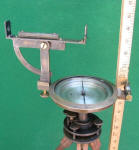 John Roach Mining Compass w/
Vernier & Clinometer
Sighting Feature This is an interesting
and unusual surveying instrument. John Roach was
originally from Scotland and relocated to NY in the 1830's. He opened up a scientific
instrument shop there first as a sole operator and later in partnership with a fellow named Warner.
Shortly after the California Gold rush of 1849 began he pulled up his
stakes and moved to California setting up shop in SF by 1855. He was soon
the largest and most prolific maker of surveying and scientific instruments there. He died in 1891.
John Roach Mining Compass w/
Vernier & Clinometer
Sighting Feature This is an interesting
and unusual surveying instrument. John Roach was
originally from Scotland and relocated to NY in the 1830's. He opened up a scientific
instrument shop there first as a sole operator and later in partnership with a fellow named Warner.
Shortly after the California Gold rush of 1849 began he pulled up his
stakes and moved to California setting up shop in SF by 1855. He was soon
the largest and most prolific maker of surveying and scientific instruments there. He died in 1891. This is a very unusual form and size surveying instrument. I do not have access to any of Roach's catalogs and so can only guess that it was intended for use in mining situations or other close in situations. It stands just a mere 39" tall on its original tripod to the top of the auxiliary sight. Joseph Sala who was Roaches assistant, and then successor after Roach's death offered a somewhat similar looking instrument and called it a Clinometer Compass.
The needle is original and approx 4". The maker name and location are on the silvered face of the compass. The needle swings freely and points north. There is a needle hold feature, but the arm to actuate it is missing. The Clinometer sighting feature is graduated to 90 degrees and has the ability to look over the edge of the compass for mining applications. The level vial is full.
There is a box which is not shown. It is missing a section of the lid and one side, and is in need of restoration. The tripod legs are a mere 30" long and have a great taper design. One of the legs is missing the bottom foot. The leveling head looks OK, and is all here, but the screw holding the two halves together is stripped and so if adjusted too much it tends to come apart. It is set up now with tape to take up the slack, and is stable, but not really useable. Instruments by Roach are pretty unusual and this is a form mining compass I have never seen before. It was made by California's premier instrument maker during it glory days of the mid to late 1800's. An important surveying / mining piece ready for inclusion in the finest collection.
Good . . . . . .$800.00 - $1500.00 SOLD!
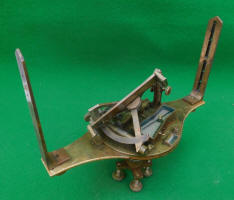 Burt
& Bailey / Detroit Michigan c. 1853 - 1855 Solar Compass in Original Box
This Burt & Bailey Solar Compass is a rare and desirable 19th Century American Surveying Instrument. This
rare Solar Compass was produced by Burt & Bailey a short lived partnership based in
Detroit MI and is an important piece of American history and
Americana.
Burt
& Bailey / Detroit Michigan c. 1853 - 1855 Solar Compass in Original Box
This Burt & Bailey Solar Compass is a rare and desirable 19th Century American Surveying Instrument. This
rare Solar Compass was produced by Burt & Bailey a short lived partnership based in
Detroit MI and is an important piece of American history and
Americana.William Burt was first granted a patent for his idea of a solar compass in 1836. There are several in depth and detailed histories that can be found online about William Burt, his solar compass invention and his 1836 patent for a solar compass. Informative links can be found below this write-up and pictures.
William Young, the famous instrument maker from PA made the first example for Burt which was submitted for the patent. Burt displayed his idea at several exhibitions and was awarded several medals for the innovative nature of the idea, but large scale production never really took off during that period. In the early 1850's production was moved to the Detroit area for a time, but with the elder Burts death, his heirs lost interest and production there came to an end shortly after.
This example was made between 1853 and 1855 by William Burt Sr.son's John and William Burt in partnership with a fellow named John Aylesworth Bailey who at that time owned the rights to manufacture them. The partnership of Burt and Bailey was in existence for 2 years or less from 1853 - 1855. It is not known how many solar compasses they produced, but it is sure not many given how few have ever been found.
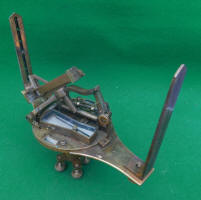
The company was reformed and renamed J & W Burt after Bailey left in 1855. That partnership was also short lived. One year later the company was again renamed Burt & Watson. Watson had previously worked for William Young in PA and was taken in as a new partner by the Burt brothers. That incarnation also lasted about 1 year.
This compass measures approx. 15 inches long.It is complete with original box, sight vanes, and leveling base. All motions work smoothly. The compass needle swings. The level bubble is good. It is in very nice overall condition with a great patina and does not look to have ever been fiddled with. It is housed in its original box which is also in nice condition. The plate is marked at one end with the partners names Burt & Bailey, and with the location, Detroit Mich. on the other. I see no other markings or serial # other than the Young label inside the top of the box.
A rare and important surveying instrument and near unique piece of Americana for the discriminating collector history buff.
Good + . . . . . . $9,500.00 SOLD!!
Further Info on Burt Solar Compass
Wikipedia has a wealth of overall information concerning solar compasses and their history that can be found at this link. https://en.wikipedia.org/wiki/Solar_compassThe original patent was hand written, and a copy can be viewed at the Survey History site https://www.surveyhistory.org/1836_solar_compass_patent1.htm
The Survey History site has a detailed history on the Burt family and the several partnerships that they were involved in http://www.surveyhistory.org/j__&_w__burt.htm
Another essay concerning Burt Solar Compasses can be found at the Wisconsin History site.
Probably the most concise and clear history of the Burt solar compass makers and partnerships can be found on the remains of Bud Uzes old surveying related site where he describes a Burt Solar Compass he owned and was being sold after his death.
I found one more short write-up on Burt Solar Compasses in an ebay ad for another Burt Solar Compass that I have included here.
William Austin Burt Solar Compass
The solar compass, an astronomical instrument, was first invented and made by William Austin Burt. He patented it on February 25, 1836, in the United States Patent Office as No 9428X. The first solar compasses are believed to have been made in the late 1830ís by Henry Ware and Leonard Nutz in Cincinnati, OH. William Young was contracted to make improved solar compasses beginning in 1841.
It received a medal at the Great Exhibition of 1851. Burt, a United States Deputy Surveyor, began surveying government lands in Michigan in 1833. While working in Wisconsin, where there were large deposits of iron ore, Burt experienced great difficulty in using his standard vernier scale compass. This motivated him to find a solution that was not dependent on magnetism and would not be influenced by earth's ore materials. With his mechanical abilities, he then devised and built the solar compass. Burt made a model of his instrument in 1835 to test its validity. The instrument was then submitted to a committee at the Franklin Institute in Philadelphia. They examined its principles and merits and ultimately awarded Burt twenty dollars in gold and the John Legacy Medal. He improved on his surveying instrument and in 1840 re-submitted it to the Franklin Institute. The instrument was further improved over the years and in 1851 he exhibited that version at the Great Exhibition in London, where he was awarded another prize medal. He then received another medal by jurors of Astronomical Instruments.
Burtís solar compass is a precision instrument made of brass with a solar attachment that allows surveyors to determine the true north direction by reference to the sun rather than by reference to the magnetic north pole. It allowed surveyors to locate true north through viewing the sun and other astronomical observations and was not influenced by magnetism or iron ore or other ore materials. The United States government required land surveys to be done by Burt's Solar compass; as in many cases the cost to accurately survey lands with heavy mineral deposits that interfered with normal instrumentation would have exceeded the value of the land.
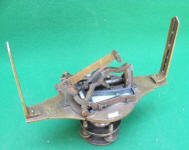 Wm.
J. Young Solar Compass w/ Leveling Head & Tripod William Young
hailed from Pennsylvania. He was born in 1800 and died in 1870.
He was Pennsylvania's most famous maker of scientific and surveying related
instruments. Young originally apprenticed to Thomas Whitney at the age of
13. He went into business for himself in the 1820's. There
is an extensive Bio on him at the Smithsonian site, as well as examples of
two similar solar compasses in the collection there. Here is a link
http://amhistory.si.edu/surveying/maker.cfm?makerid=38. Young is
credited by many to be the first to develop and introduce the concept of a
transit in America and made the first dividing engine used in America.
Wm.
J. Young Solar Compass w/ Leveling Head & Tripod William Young
hailed from Pennsylvania. He was born in 1800 and died in 1870.
He was Pennsylvania's most famous maker of scientific and surveying related
instruments. Young originally apprenticed to Thomas Whitney at the age of
13. He went into business for himself in the 1820's. There
is an extensive Bio on him at the Smithsonian site, as well as examples of
two similar solar compasses in the collection there. Here is a link
http://amhistory.si.edu/surveying/maker.cfm?makerid=38. Young is
credited by many to be the first to develop and introduce the concept of a
transit in America and made the first dividing engine used in America. This solar compass is an early and significant type of surveying instrument. The idea was first developed by William Burt in the 1830's. They were developed to be used in place of regular compasses that were subject to error due to large deposits of iron that would adversely affect a regular compass. The idea was to use the sun and horizon to accurately find ones position. Young made the first example for Burt to submit to the Patent Office. The Smithsonian has information on this story at the link below http://amhistory.si.edu/surveying/ype.cfm?typeid=17 Young first started producing them for sale in 1840 and went on to refine the idea adding features and perfecting the design for this specialized form instrument. There is a serial number inside the glass compass of 3554 which would date it from approx. 1853. Young first started using serial numbers in 1850
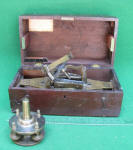 starting the numbering at 3000.
starting the numbering at 3000.The box is mahogany box has a later label in it from Young and Sons. It was probably affixed after a repair or adjustment. There are 2 adjusting bars still present inside the box.There is a space in the box for what may have been a scope but that space is empty The compass plate has extra holes under one sight vane that may have been for mounting a scope.A similar instrument w/ scope sold for approx. 30,000 a few years ago on eBay.
The overall condition is very nice with original patina. All motions operate, and the plate moves freely. The vernier scale has 2 windows covering the silver scale there. Both level vials are good. The plate on one end is marked "Made by Wm. J. Young Philada". The plate at the other end is Marked Burt's Patent. The tripod and leveling head are in very nice condition, fit well and seem to be original. An important surveying related instrument ready for inclusion in the finest collection.
Fine . . . . . .$10,000.00 - $25,000.00 SOLD!! < 2019 > More like 6K - 10K these days
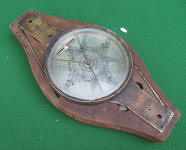 Lewis
Michael 18th Century Surveying Compass This
early Lewis Michael surveying compass is a piece of 18th Century Americana with
historical importance. The compass is in fine untouched original condition and
includes its original hump back wooden case. Lewis Michael
was an 18th Century
maker of Surveying Instruments, clocks, and related accessories who hailed first
from Pennsylvania, and later moved to Ohio. Lewis Michael was born about 1765
and his working dates are from
approx. 1785 to the 1830's. There are just a handful of Lewis Michael surveying
instruments or compasses known.
Lewis
Michael 18th Century Surveying Compass This
early Lewis Michael surveying compass is a piece of 18th Century Americana with
historical importance. The compass is in fine untouched original condition and
includes its original hump back wooden case. Lewis Michael
was an 18th Century
maker of Surveying Instruments, clocks, and related accessories who hailed first
from Pennsylvania, and later moved to Ohio. Lewis Michael was born about 1765
and his working dates are from
approx. 1785 to the 1830's. There are just a handful of Lewis Michael surveying
instruments or compasses known. Lewis Michael is not listed in Smart's book, "The Makers of Surveying Instruments in America Since 1700". Nor is he included in the book about the collection Smart curated for Gurley.The Smithsonian does not have an example in their collection either. There are two example shown at the SuveyHistory.org site in the compass directory found
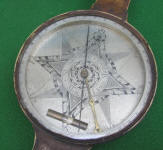 there. There is a short bio on Lewis Michael at
that site as well. One of those compasses is marked "Somerset",
as is this example, and the other
"York", both of which are in PA. Note that this compass lists off
the PA location while those examples do not. Both of those compasses have other subtle differences
from this example. I also found two articles online that make mention of and
picture Lewis compasses. It is not known if those are the same two
compasses that are pictured at the SurveyHistory.org site.
there. There is a short bio on Lewis Michael at
that site as well. One of those compasses is marked "Somerset",
as is this example, and the other
"York", both of which are in PA. Note that this compass lists off
the PA location while those examples do not. Both of those compasses have other subtle differences
from this example. I also found two articles online that make mention of and
picture Lewis compasses. It is not known if those are the same two
compasses that are pictured at the SurveyHistory.org site.One article was written by Silvio A. Bedini, who worked for the Smithsonian and is a well known authority on early Colonial Era Surveying Instruments. The article is titled "Benjamin Rittenhouse and His Apprentices and Partners." That article gives a good bit of history about Lewis Michael and Benjamin Rittenhouse. Benjamin Rittenhouse was a famous 18th century maker of surveying instruments and clocks. He learned the trade from his brother David Rittenhouse, who it is said made scientific instruments for George Washington and worked for other well known early American figures including Jefferson and Franklin. Bedini states that Lewis Michael was Benjamin Rittenhouse's earliest apprentice and began working for Benjamin Rittenhouse in 1779 when he was about 14 years old. The article goes on to document his activities in PA through the years using tax records and directory entries. Lewis moved to Ohio in the 1830's and in an ad announcing that move he claimed he had learned the trade from Benjamin Rittenhouse. Lewis also advertised that he was a clock maker among other things. I could find no mention of, or examples of Lewis Michael clocks online.
The second article was written by Jeffery Lock, who operates the website Colonialinstruments.com. The title of the article is "The Art of Brass Colonial Surveying Instruments". It can be found online. In that article he tells of buying a Lewis Michael compass because of the beauty of the engraving and level of craftsmanship the compass exhibited. He explains that only later did he learn about the maker and come to recognize Lewis Michael's importance, describing him as one of the "foremost instrument makers of the Colonial period". Lock goes on to say "His instruments are extremely desirable and very hard to find on the open market."
The compass plate is 14" long and the compass itself is approx. 6" diameter, with a 5 1/4" long original needle. The compass face is silvered and nice. The engraving work is superb and highly detailed. The engraving has a large and very complex 8-point rose with wonderful details and complexities in its design and execution. The four main points have smaller inside points with the borders between them heavily engraved in decorative 18th century style. This compass is a work of art that is equal if not superior to the work of other instrument makers like the Rittenhouse brothers or Goldsmith Chandlee of Virginia. The bubble under the glass is good and original. The sight vanes are nice and the screws for them are original. The compass has a built-in dial / outkeeper numbered 0 - 16 which is functional. There are several empty screw holes on the underside. It is interesting to note that every screw on the bottom is punch pricked with dots so as to number them for their holes.The blued needle swings to North, and the needle lifter works. The hump backed box with its precisely fitted cutouts and unique design is original and made of an unknown dark colored softwood.
This Michael Lewis compass and the box are both incredible pieces of early American craftsmanship and workmanship. This Michael Lewis colonial era surveying instrument represents a rare opportunity to own a piece of historical Americana that may never present itself again. Highly recommended!!
Fine . . . . .
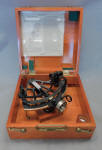 Dritz / Schick Inc. Sextant Type Stadimeter The tag on the outer box
says it was for the U. S. Maritime Commission. It does not appear to have
ever made it to sea. Near mint unused condition. Instructions inside
the lid indicate WWII era. It will display very nicely!!
Dritz / Schick Inc. Sextant Type Stadimeter The tag on the outer box
says it was for the U. S. Maritime Commission. It does not appear to have
ever made it to sea. Near mint unused condition. Instructions inside
the lid indicate WWII era. It will display very nicely!! Good + . . . . . . $295.00 SOLD!!
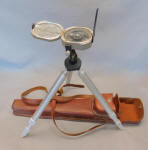 WM. Ainsworth & Sons
- D. W. Brunton Pocket Transit / Compass w/ Tripod & Long Leather Case
The real deal. All good.
WM. Ainsworth & Sons
- D. W. Brunton Pocket Transit / Compass w/ Tripod & Long Leather Case
The real deal. All good. The serial # is 106375. The entire setup is in about as nice condition as one could ask for. Super condition w/ no apologies.
Fine . . . . . . $395.00 SOLD!!
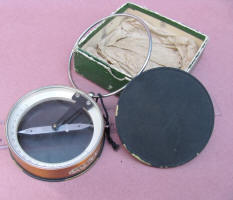 K
& E #5293 Miners Compass / Dipping Compass
This dip compass is NOS and has just minor loss to the finish along the edges.
These were used as locators for all things magnetic, from pipes to ore.
There was a period when makers / sellers dressed them up a bit, put handles on them, and
told the American public that they could find their riches using the one
they offered.
K
& E #5293 Miners Compass / Dipping Compass
This dip compass is NOS and has just minor loss to the finish along the edges.
These were used as locators for all things magnetic, from pipes to ore.
There was a period when makers / sellers dressed them up a bit, put handles on them, and
told the American public that they could find their riches using the one
they offered.
Excellent. . . . .$100.00 - $200.00 SOLD!!
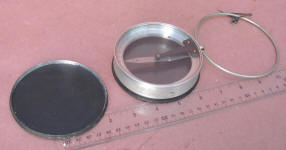 K
& E Miners Compass / Dip Compass
The body of this one is made of Aluminum. It is the same idea as
the other K & E compasses listed above.
K
& E Miners Compass / Dip Compass
The body of this one is made of Aluminum. It is the same idea as
the other K & E compasses listed above.
Good + . . . .$100.00 - $200.00 SOLD!!
 K
& E #5334 Surveyors Compass This compass
is in very nice condition overall. The 2 level vials are dry but these are
easily replaceable and not a big concern. The ball joint is here, and the
mahogany box is original and has a great bubbly patina to the finish making it look
200 years older than it is. The needle is approx. 4" making this a #5334
K
& E #5334 Surveyors Compass This compass
is in very nice condition overall. The 2 level vials are dry but these are
easily replaceable and not a big concern. The ball joint is here, and the
mahogany box is original and has a great bubbly patina to the finish making it look
200 years older than it is. The needle is approx. 4" making this a #5334
Good+ . . . . .$195.00 SOLD
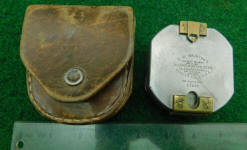 D. W. Brunton
Pocket Transit / Compass by Ainsworth Brunton Pocket Transit, by W.M. Ainsworth & Sons, Denver Colorado, Made In
USA. This pocket transit is in good operating and cosmetic condition. The serial number #17406. This pocket transit has not been cleaned or touched-up in any way. It comes in a
proper leather case that is OK and has seen use
D. W. Brunton
Pocket Transit / Compass by Ainsworth Brunton Pocket Transit, by W.M. Ainsworth & Sons, Denver Colorado, Made In
USA. This pocket transit is in good operating and cosmetic condition. The serial number #17406. This pocket transit has not been cleaned or touched-up in any way. It comes in a
proper leather case that is OK and has seen use A history of Brunton and Ainsworth, including instruction on use can be found on line at the site / link https://oldtopographer.net/the-topographers-tools/brunton-pocket-transits/ A small snippet of Info from there is that Brunton the inventor contracted with Denver-based instrument maker William Ainsworth & Sons to produce the first pocket transits. Ainsworth remained the primary manufacturer of Brunton pocket transits until after WWII. In 1972 the Ainsworth company folded and the Brunton company was formed to continue production. Original Brunton compasses are still manufactured today in Riverton, Wyoming.
Good + . . . . . . $150.00 SOLD!!
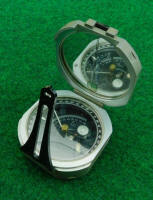 D. W. Brunton Pocket Transit / Compass by Ainsworth
Brunton Pocket Transit, by W.M. Ainsworth & Sons, Denver Colorado, Made In
USA. This pocket transit is in good operating and cosmetic condition. The
serial number #43759. This pocket transit has not been cleaned or touched-up in any way. It comes in a
proper leather case that is OK but well used.
D. W. Brunton Pocket Transit / Compass by Ainsworth
Brunton Pocket Transit, by W.M. Ainsworth & Sons, Denver Colorado, Made In
USA. This pocket transit is in good operating and cosmetic condition. The
serial number #43759. This pocket transit has not been cleaned or touched-up in any way. It comes in a
proper leather case that is OK but well used. A history of Brunton and Ainsworth, including instruction on use can be found on line at the site / link https://oldtopographer.net/the-topographers-tools/brunton-pocket-transits/ A small snippet of Info from there is that Brunton the inventor contracted with Denver-based instrument maker William Ainsworth & Sons to produce the first pocket transits. Ainsworth remained the primary manufacturer of Brunton pocket transits until after WWII. In 1972 the Ainsworth company folded and the Brunton company was formed to continue production. Original Brunton compasses are still manufactured today in Riverton, Wyoming.
Fine . . . . . . $150.00 SOLD!!
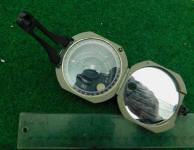 D.
W. Brunton Pocket Transit / Compass This
Brunton Pocket Transit is in good operating and cosmetic condition. This pocket transit has not been cleaned or touched-up in any way. It comes in a
damaged plastic case.
D.
W. Brunton Pocket Transit / Compass This
Brunton Pocket Transit is in good operating and cosmetic condition. This pocket transit has not been cleaned or touched-up in any way. It comes in a
damaged plastic case.A history of Brunton and Ainsworth, including instruction on use can be found on line at the site / link https://oldtopographer.net/the-topographers-tools/brunton-pocket-transits/ A small snippet of Info from there is that Brunton the inventor contracted with Denver-based instrument maker William Ainsworth & Sons to produce the first pocket transits. Ainsworth remained the primary manufacturer of Brunton pocket transits until after WWII. In 1972 the Ainsworth company folded and the Brunton company was formed to continue production. Original Brunton compasses are still manufactured today in Riverton, Wyoming.
Good + . . . . . . $150.00 SOLD!!
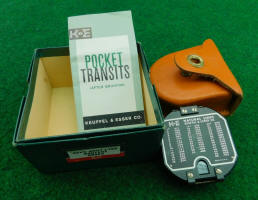 K & E / Keuffel & Esser Brunton Pocket Transit / Compass
A Brunton Pocket Transit / Compass instrument offered by K & E.
It is identical in operation and design. This pocket transit is
in good operating condition noting the mirror could be replaced.
K & E / Keuffel & Esser Brunton Pocket Transit / Compass
A Brunton Pocket Transit / Compass instrument offered by K & E.
It is identical in operation and design. This pocket transit is
in good operating condition noting the mirror could be replaced. A history of Brunton and Ainsworth, including instruction on use can be found on line at the site / link https://oldtopographer.net/the-topographers-tools/brunton-pocket-transits/
Good + . . . . . . $75.00 SOLD!!
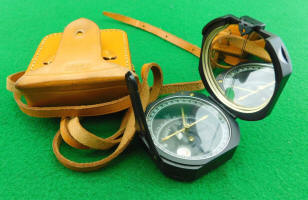 Keuffel & Esser / K& E # 5368 - 1 Pocket Transit (after Brunton)
Keuffel & Esser / K& E # 5368 - 1 Pocket Transit (after Brunton)
Fine. . . . .$195.00 SOLD
This is just a sample of the many
antiques & collectibles we have sold.
Click link to see other
Sales Archive Pages on this Site.
We Buy Quality Surveying Related Antiques
Contact Us at
AntiqBuyer@gmail.com
Our current offering of Antiques for sale are at our sister Website Patented-Antiques.com.
This website is Copyrighted
Larry & Carole Meeker